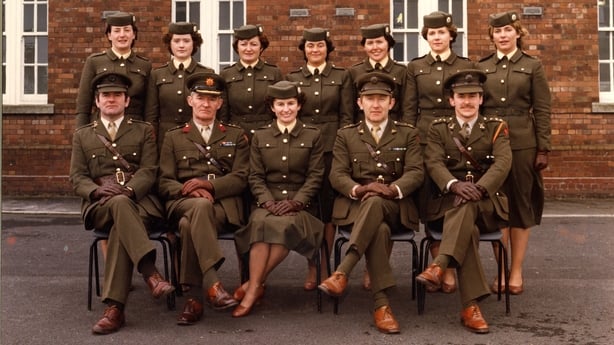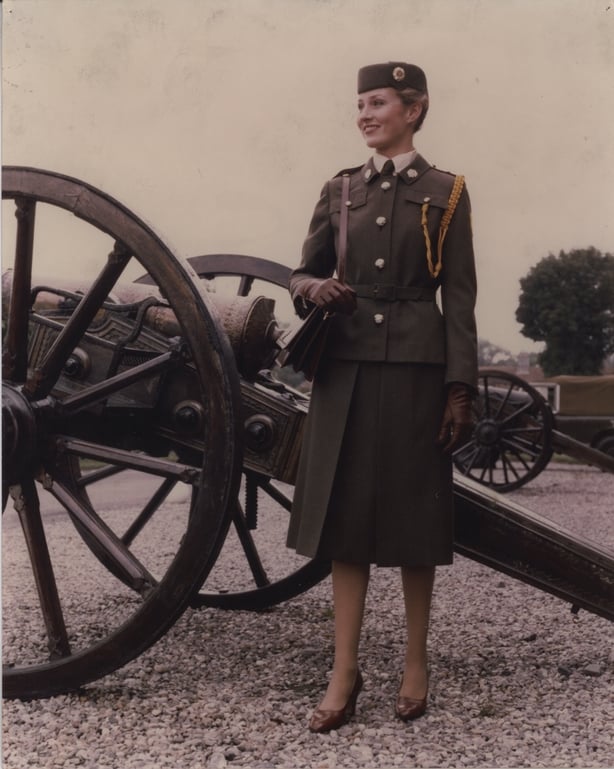Analysis: a casual dismissal of the value women might add to the Defence Forces was baked into the system from the very beginning
By Eoin Kinsella, Royal Irish Academy
The recent findings of the Independent Review Group's investigation into dignity and equality issues in the Defence Forces offer a sobering insight into the failures both of the Defence Forces and the Department of Defence to adequately protect the women who have served with the nation's military. These failures come despite the emergence of distressing details of bullying and sexual harassment at the turn of the millennium, and the implementation of major reforms of disciplinary structures between 2004 and 2014.
We need your consent to load this rte-player contentWe use rte-player to manage extra content that can set cookies on your device and collect data about your activity. Please review their details and accept them to load the content.Manage Preferences
From RTÉ Radio 1's Women of Honour, Katie Hannon looks at bullying, misogyny and violence towards women within the Irish Defence Forces
But when did women first join the Defence Forces? The slightly misleading answer is 1922, when Dr Brigid Lyons Thornton, a veteran of the revolutionary movement, received a commission from Michael Collins in the provisional government's National Army. Thornton served until a serious bout of tuberculosis ended her military career two years later.
Thornton, however, remained the only woman commissioned in the Defence Forces for almost six decades. By the 1970s, Ireland was out of step with many of its international counterparts when it came to the recruitment of women. Proposals to allow women join the Defence Forces surfaced by the middle of the decade, and a commitment to do so was included in Fianna Fáil's 1977 election manifesto.
In September of that year, a joint committee consisting of representatives from the civil and military branches of the Department of Defence examined the potential creation of a Women’s Service Corps (WSC). It received advice from military forces in other small European countries, and its first report included the rather underwhelming conclusion that this could have a 'useful role’ as part of the Defence Forces.

Inequality and an enduring, casual dismissal of the value women might add to the Defence Forces were baked into the system from the very beginning. That much was clear not just from the joint committee’s report, which also recommended that women should be paid less than their male counterparts, but also from the memorandum submitted by Minister for Defence Bobby Molloy to government in June 1979, formally recommending the establishment of the Corps.
Among the arguments advanced in support was that the WSC could participate in a 'worthwhile and conspicuous manner in ceremonial occasions’. Female personnel would also be non-combatant and ineligible for duties of a security or operational nature under arms.
There were some dissenting voices to these restrictions. Deputy Adjutant General Col. P.J. Daly complained that the Corps didn’t provide a satisfactory career structure for women. Daly also warned that the combat efficiency of the Defence Forces would be reduced if non-combatant personnel were recruited. But his solution was to ensure that the number of men being recruited was not curtailed, rather than to argue that restrictions on women’s service should be removed. More predictably, there were fears that male personnel would be denied opportunities for advancement.
We need your consent to load this rte-player contentWe use rte-player to manage extra content that can set cookies on your device and collect data about your activity. Please review their details and accept them to load the content.Manage Preferences
From RTÉ Archives, an 1981 episode of Off the Wall follows female recruits to the Irish Defence Forces being put through their paces in the Curragh.
Such concerns were ignored, and Government approval for the WSC was granted on June 12th 1979, which required enabling legislation passed by the Oireachtas later that summer. Inequalities in treatment persisted. While four cadetships were initially offered to train the Corps' first officer intake, female entrants to the Military College were expected to have a university degree, but male cadets needed only a Leaving Certificate, a stipulation objected to by the Department of Finance as equivalent to gender discrimination.
Despite this, more than 1,000 applications were received by the beginning of December 1979. Just four women were selected from that group and Maria O'Donoghue, Colette Harrison, Máirín McEnery and Maree Flynn arrived at the Curragh to begin training on March 10th 1980. On April 27th 1981, the first eight female cadets received their commissions, and the first cohort of female recruits – 38 in total – passed out as members of the 4th platoon at the Curragh on October 29th, under the command of Lt Maria O’Donoghue.
We need your consent to load this rte-player contentWe use rte-player to manage extra content that can set cookies on your device and collect data about your activity. Please review their details and accept them to load the content.Manage Preferences
From RTÉ Archives, RTÉ News report on the first women recruits to the Defence Forces in 1981
But the WSC was disbanded that same month, in recognition of the difficulty of maintaining a corps that lacked appropriate command and administrative structures and hadn’t been fully integrated into the Defence Forces. Female personnel were instead posted to units on the same basis as that applied to male soldiers, subject to certain limitations. Recruitment of women thereafter was slow: there were 89 women in the Permanent Defence Forces (31 officers, 19 NCOs and 39 privates) by 1991, constituting just 0.7 per cent of total strength.
A decade after their admission, women were still prevented from fulfilling duties of an operational or security nature under arms. With just a few exceptions, they were not permitted to serve as officers in the Infantry, Artillery or Cavalry Corps, and were restricted to serving at force headquarters while serving on UN peacekeeping missions.
In the Air Corps, women pilots were not permitted to fly in armed support roles, or to take part in Aid to the Civil Power operations. In 1989 a slight modification was introduced, with women allowed to serve as orderly officers in barracks, while competition for apprentice schemes was finally opened to all in 1991. These tiny concessions were mere window dressing, however, providing little gloss to the remaining inequalities.

Reviewing the integration of women into the forces in 1990, the general staff prepared to double down on the status quo. The Adjutant General's office issued a report recommending retention of the existing policy, despite hindering women officers’ career progression by restricting them to just 55% of possible appointments. When approved by then Tánaiste and Minister for Defence Brian Lenihan, the decision met with strong criticism by female officers. Their protests were bolstered by the Judge Advocate General's office, which submitted a counter-report recommending the abandonment of such a discriminatory policy.
Recognising the level of dissatisfaction with the status quo, Chief of Staff Lt Gen James Parker convened a board in October 1991 to re-examine the issue. In a belated recognition of the fact that international norms increasingly tended towards full integration of women soldiers, the board recommended that women be allowed to fully participate in all aspects of Defence Forces' duties, including operational work, and to have equal access to the career educational system and promotion opportunities. Restrictions on deployment of women soldiers under arms were lifted in 1993, and the full integration of women was achieved over the remainder of the decade.
The Irish Defence Forces, 1922–2022 is published by Four Courts Press
Dr Eoin Kinsella is managing editor of the Royal Irish Academy's Dictionary of Irish Biography
The views expressed here are those of the author and do not represent or reflect the views of RTÉ

